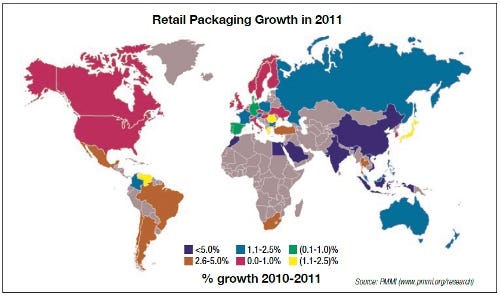Want to grow product sales? Go west, young man. And north and south and east. The best opportunities for expansion lie in places like Sao Paulo, Cape Coast and Mumbai.
Whether or not your products are currently sold in Brazil, Ghana or India, chances are your company's future depends on reaching new consumers in the developing world. Why? Because that's where the growth is and will continue to be for the next decade or more.
In 2012, the share of gross domestic product (GDP) as a percentage of the global market is shifting from developed countries to the emerging and developing countries, according to research by PMMI in cooperation with Euromonitor Intl. Jorge Izquierdo, vp, market development, PMMI, says, "More of the economic activity is moving towards developing countries. In years to come, as a projection to 2020, it's expected that this shifting will continue, moving forward."
Izquierdo cites the main reasons for this shift: More people have more money to spend and places to shop so the demand for consumer goods is exploding in certain areas. Flocks of consumers in the developing world are joining the middle class and now enjoy some disposable income. Combine this with the growth of retail outlets and it's no wonder why packaging is in high demand. "If we were to follow the growth of supermarket chains in the different countries, we can tie that very closely with the use of packaging," Izquierdo says.

Retail Packaging Growth
How is this playing out by the numbers? In 2011, retail packaging grew at 5 percent or greater in areas such as China and Asia/Pacific (see color-coded world map above). In contrast, the more mature North American market sits at a modest 0.3 percent compound annual growth rate for retail packaging, which includes primary packaging such as bottles, bags, cartons and pouches.
To round out the picture, the chart (below) shows retail packaging volumes, as well as growth, by region, comparing the number of billion units sold in 2006 and 2011. Asia Pacific, led by China's dramatic expansion, emerges as the clear winner in both volume and growth percentage.

Retail Packaging by Region
Packaging's place
Thomas Schneider, CPP, president of the World Packaging Organisation, identifies packaging as the "common denominator," able to cut across cultures and regions in the global marketplace. "Packaging is a unique tool common to virtually every culture on earth. Packaging is essential for quality of life in terms of safe food, clean water and secure pharmaceuticals," Schneider says.
Yet he advises packaging professionals to consider regional differences rather than global similarities. "Packaging must be adaptive. In North America, packaging is not just protective—but a silent salesperson," Schneider says. "In Ghana, it's a small bag of clean water needed to quench someone's thirst. It's not fancy-but it's effective."
Likewise, when introducing packaging technologies to these countries, think "simple" value added. "Does a plant that is bottling 50,000 bottles of juice per day need the expensive, high-speed technology that processes 500 bottles a minute?" Schneider says.
His advice for packaging machinery manufacturers? "Offering machinery that is fit for purpose means that some of our less sophisticated technology might meet the customer's requirements, while the development costs were amortized quite a while ago. This could lead to even higher profit margins," Schneider adds.
Real world example
Among the challenges of operating a smooth-running international packaging organization is making sure the right people are sharing the right information across time zones.
To do this, global pharmaceutical leader Pfizer set up a packaging network leadership team called Pac-Net to connect and leverage its packaging design and manufacturing operations. No easy task, given the company's vast and complex supply base. Pfizer has 92 manufacturing sites around the world that use more than 40 technologies and platforms, works with more than 500 supplier partners, produces 35,000 SKUs and sells products in 33 countries.
An inclusive group, the Pac-Net team is aligned along six common interest groups: Complexity Management; Packaging Performance; Organizational Effectiveness; Responsible Packaging Design; Artwork and Labeling Excellence; and Innovative Equipment Technologies.
There's good reason for such diversity in Pac-Net. Bina Nair, director, global solids and packaging networks, Pfizer Global Supply, explains: "The goal is to make sure that it's not a few people who sit in New York or in one particular organization making decisions on behalf of the network. It's truly making sure that there's broad reach, communication across the network, leveraging insights, leveraging those cultural and local regulations that might impact what we might be considering, and making sure that the different parts of the organization are able to use whatever processes or technologies that we come up with that impact packaging."
Striking the right balance is key, too. Nair says, "One of the things we're conscious of with Pac-Net is to make sure that our network includes our procurement professionals. They're a corporate group but they have local representation in every region and key markets. Where possible, we leverage corporate contracts with global suppliers. But, to meet the needs of the business, there's a need to partner with local material vendors as well."
Whether you set up your own shop or opt to partner with the natives, growing your packaging department internationally will expand your company's horizons in more ways than one.
Euromonitor Intl., 312-922-1115. www.euromonitor.com
PMMI, 703-243-8555. www.pmmi.org; www.packexpo.com
World Packaging Organisation, 713-675-5391. www.worldpackaging.org
DEEPER DIVE
On Aug. 28, 2012, Packaging Digest conducted a live one-hour webcast entitled "Opportunities in the Global Packaging Market." This article relates highlights of the presentations from Jorge Izquierdo, vp, market development, PMMI; Thomas Schneider, CPP, president, World Packaging Organisation; Bina Nair, director, global solids and packaging networks, Pfizer Global Supply; and Lenny Figorski, associate director, packaging processes and systems, Pfizer Packaging Services. You can access the PowerPoint slides and webcast recording, including the Q&A period at the end, by simply registering here: www.packagingdigest.com/GlobalWebcast
.
About the Author(s)
You May Also Like




